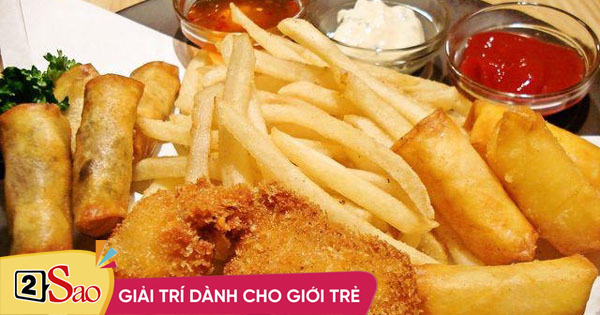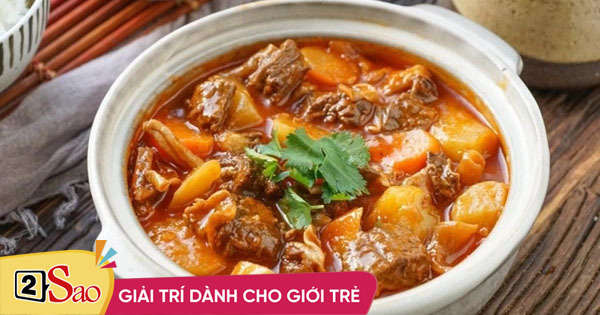On the 3rd day of the third lunar month, Korean New Year cannot be complete without a vegetarian cake. So why eat these two cakes?
1. The meaning of the New Year’s Day of floating cake, vegetarian cake in Vietnam
The custom of real Korean New Year (Tet eating cold food) originates from China, in the past, on this occasion, people often did not light a fire for 3 days and only eat cold food that has been cooked before. Each family prepares floating cakes and vegetarian cakes to offer to the altar, in remembrance of ancestors’ grace.
However, unlike China, the real Korean New Year in Vietnam, people do not abstain from fire, everything cooks normally. Due to long-standing cultural exchanges with China, some Vietnamese families also have the habit of worshiping real Korean New Year.
In Vietnam, the Korean New Year has a deep national meaning. The use of floating cakes and vegetarian cakes to worship represents the wet rice culture. Both cakes are made from fragrant glutinous rice flour, the result of hard work to offer to grandparents and ancestors. In many places, people make floating cakes and vegetarian cakes to worship the gods.
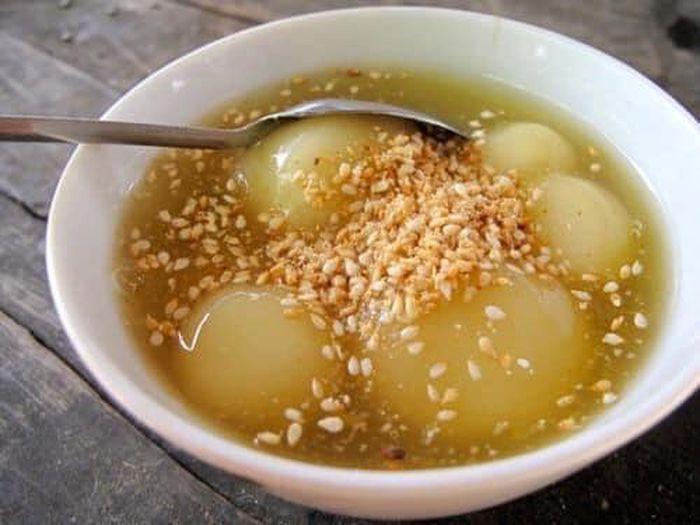
Floating cake.
Cold Food Festival of Vietnamese people mainly have the meaning towards the origin. Drift cake, vegetarian cake is also a way to commemorate the “wrapping hundred eggs” of Au Co and Lac Long Quan. Drift cake symbolizes 50 eggs that hatch into 50 children who follow Au Co’s mother to the mainland to live.
Vegetarian cake represents 50 eggs, which hatch into 50 children who follow Father Lac Long Quan to the sea. Therefore, the small cakes have a clear and white shape to look like a hundred eggs.
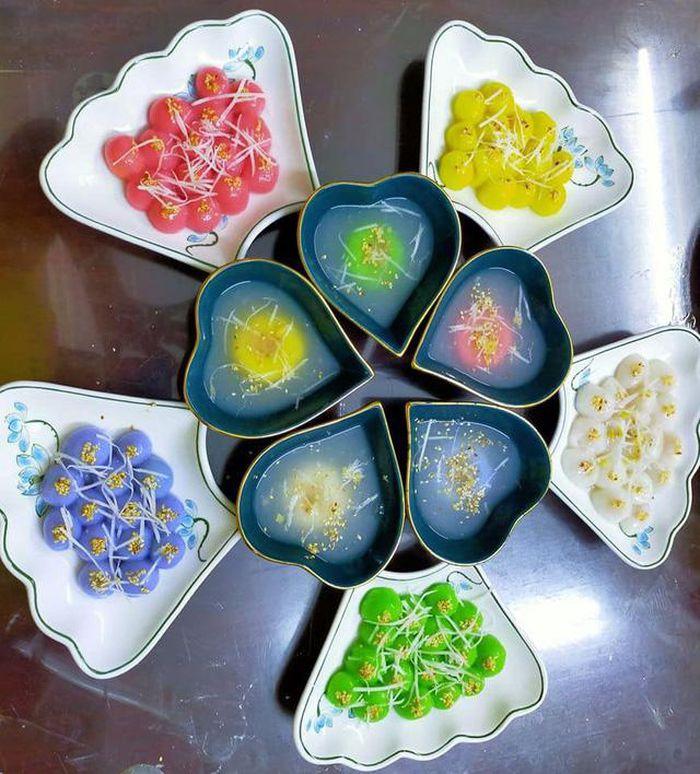
Nowadays, floating cakes and vegetarian cakes are painted with eye-catching food coloring.
2. What does the traditional Korean New Year offering tray include?
The two types of floating and vegetarian cakes are made from fragrant glutinous rice flour. The floating cake is molded into small balls, white outside, red sugar inside, boiled in a pot of boiling water, when the cake floats to the surface, take it out and just cooked. As for the vegetarian cake, it is round and flat, without filling, placed on a small plate, when eating, pour sugar water on top. These two types of cakes represent the aspiration for good, full, and pure things in life.
The tray of offerings for Korean New Year is really indispensable without floating cakes and vegetarian cakes. The number of bowls of floating cakes and vegetarian cakes on the tray is usually 3 or 5, depending on each family.
The real Korean New Year is also an occasion to pay homage to the ancestors. Therefore, the actual Korean New Year offering tray, in addition to floating cakes and vegetarian cakes, is indispensable for fresh flowers, betel nut, and incense to display on the altar. Many families arrange an extra plate of fruit to make the offering tray full and decent.
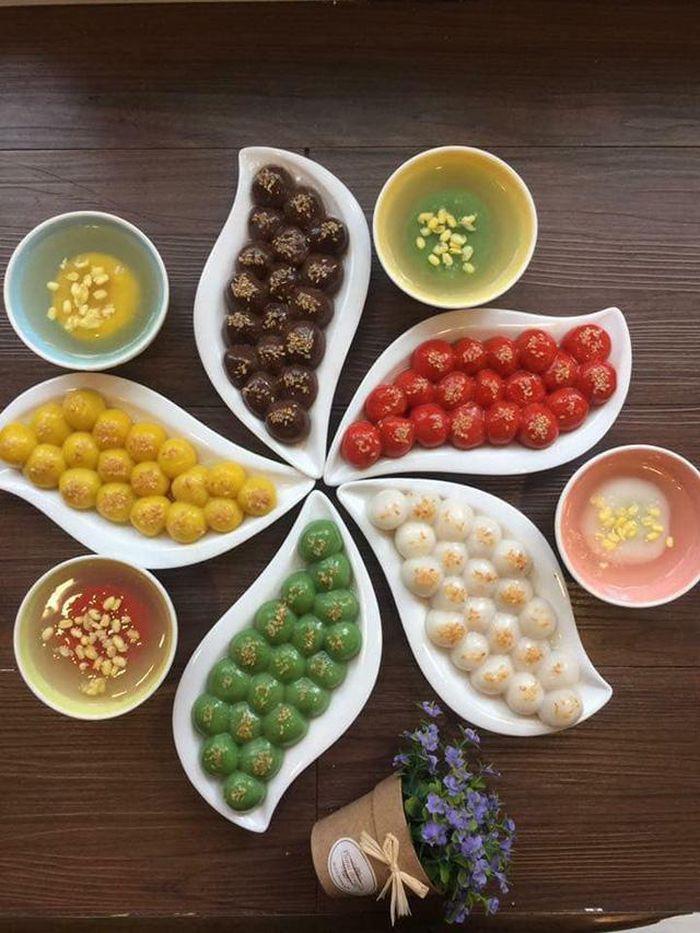
Drift cake, five-color vegetarian cake.
3. Nutritional value of floating cake, vegetarian cake
Drift cake, vegetarian cake is considered a healthy food. Specifically, the nutritional value of 100 grams of sticky rice includes:
74.9g glucide, 8.6g protid, 1.5g lipid, 14g water, 0.6g cellulose, 0.8g ash, 32mg calcium, 98mg phosphorus, 1.2mg iron and some vitamins like B1, B2, PP.
According to traditional medicine, glutinous rice is sweet, warm, and can enter the three meridians of spleen, taste and waste; has the use of tonic gas, beneficial for spleen and stomach, useful for waste only khan, often used to treat tuberculosis, leprosy due to weak spleen and stomach, management system, self-khan, Dao khan and multi-khan, pepper. thirst, illusory vocabulary due to blood damage.
Glutinous rice rich in flour is the main nutrient in the diet of Vietnamese people. If there is a lack of starch when eating, it is easy to lower blood sugar, tired people, weak limbs, difficult to concentrate at work, hungry stomach …
Since time immemorial, rice has always been a cherished farmed product, likened to a real pearl. Among them, there is glutinous rice, the type of rice used to make sticky rice, cakes… Glutinous rice is rich in nutrients: it has protein, sugar of all kinds, starch, B vitamins (found in rice bran) and inorganic substances. …
4. Who should not eat a lot of floating cakes, vegetarian cakes?
Although it is a traditional dish, on real Korean New Year, some people should not eat a lot of floating cakes and vegetarian cakes:
– People with diabetes: Because the filling contains sugar and contains a lot of sweets, people with diabetes should not eat this dish to avoid the blood sugar index being too high.
– Obese people: Overweight and obese people need to limit carbs. Dumpling cake is made entirely of rice flour, so this is also a dish not for obese people.
– People with cardiovascular disease, stomach: If you eat too much floating cake, it can increase the burden on blood circulation, making the heart tired. Dumplings also promote gastric acid secretion, making the patient’s condition worse.
– People with poor digestive system: Dumplings are mainly made from glutinous rice flour, if eaten a lot, can cause heat, bloating, belching, not suitable for people with poor digestion such as the elderly and young children.
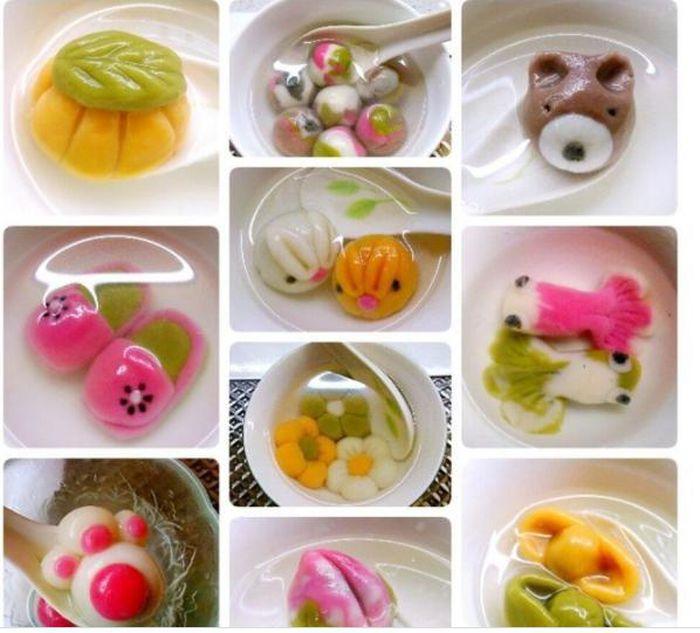
Drift cake, vegetarian cake is made from glutinous rice and is considered a healthy food.
5. How to make floating cake, vegetarian cake
* Ingredients for 1 bowl of vegetarian cakes and 1 small plate of floating cakes
Glutinous flour: 200 grams
Dumpling sugar: about 12-14 small balls
Chickpeas, peeled: 30 grams
White sesame
Coconut milk, shredded coconut (optional)
Tapioca flour/ tapioca flour or tapioca flour
* Making:
Step 1: Prepare cake dough
– Put the dough into a large bowl, slowly pour 1 cup of warm water into the flour bowl, stir with a chopstick, then knead with your hands until the dough is smooth, firm in your hand, not too mushy and not too dry.
– Use food wrap to wrap the dough to prevent it from drying out to prepare two types of fillings and sesame seeds to sprinkle on the cake.
Step 2: Prepare the vegetarian cake filling
Vegetarian cake filling: Soak green beans in warm water for 2-3 hours or overnight. Put the green beans in the pot, pour the water over, and set the heat to medium. After the water boils for a while, lower the heat, add sugar and a little salt, season to taste sweet, continue to cook until the water dries up. While boiling, use a spoon or large ladle to mash and beat the green beans until smooth and soft. If the water dries up too quickly and the green beans are not cooked and soft, add more water.
After the green beans are cooked and pureed, they are held in small handfuls the size of a quail egg. You should grasp the beans while the beans are still warm, the beans will stick better, you can add grated coconut into the filling, as you like.
– Sesame sprinkled on the cake: Roast about 2-3 tablespoons of white sesame, set aside in a bowl.
Step 3: Squeeze floating cake, vegetarian cake
– Divide the dough into several small equal parts and fit the amount of prepared filling. Flatten each dough block, put the filling in the middle and wrap it up, round it. Try to make it so tight, don’t let air get inside the filling, when the cake is cooked it will easily break.
Step 4: Boil floating cake, vegetarian cake
– Drop the molded cake into a pot of boiling water, boil until the cake floats and clear, then remove and drop into a bowl of cold water. Then, use a punctured ladle to remove the plate so that it is beautiful and then decorate the roasted sesame on the top of the cake.
– How to cook vegetarian cake: Dissolve tapioca flour with 100g of sugar and water, put it on the stove to boil so that the cassava mixture is thick and liquid, then turn off the heat, add grapefruit juice to create a fragrance.
– The vegetarian cake is scooped out into a bowl, adding tapioca juice. You can sprinkle a few more cooked beans or a few shredded coconut fibers (if desired).
Note: To create colorful and attractive floating cakes and vegetarian cakes, you can use natural colors from some types of pandan leaves, green tea, beets…
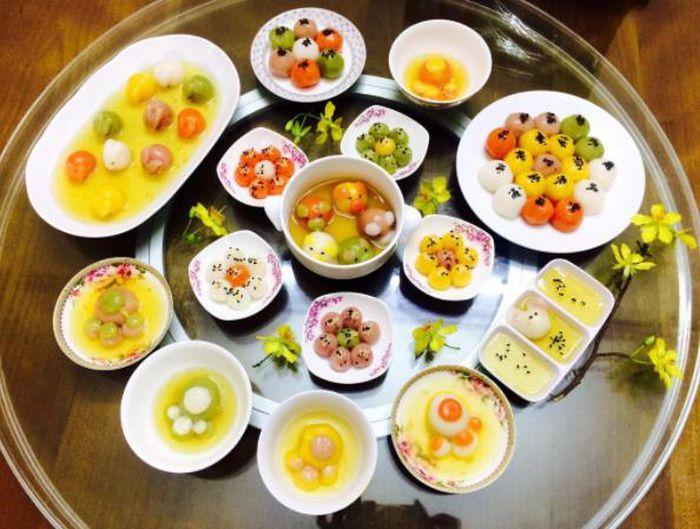
Some people should not eat a lot of floating cakes and vegetarian cakes.
6. How to color the dough for floating cakes, vegetarian cakes
– Make red powder from Gac: You put 100gr of glutinous rice flour in a bowl, add 40gr of white sugar, 30gr of cornstarch. After soaking Gac rice with a little wine and a little water, squeeze out the secreted part of Gac meat and pour it into a bowl of flour, knead through and see that the dough is still dry, add 60-70ml of warm water about 40oC, pour slowly, pour and knead. Do not pour all the water in at once to avoid spoiling the dough.
If the dough has enough water, then you stop, knead with your hands, if the dough is still wet, add a little dry flour to knead until the dough is smooth and does not stick to your hands (should wrap the dough in food wrap to prevent the dough from drying out).
– Make green powder with matcha: Put green tea powder in a bowl and add 50ml of hot water, dissolve the powder and filter through a sieve to remove the green tea residue. Pour 100g of glutinous rice flour into a bowl, add 30g of cornstarch, 40g of white granulated sugar and mix the ingredients together.
Slowly pour green tea into the bowl of flour; Just pour while stirring with a spoon until enough water stops, if there is lack of water, add a little warm water about 40oC and knead until the dough is smooth and does not stick to your hands. If the dough is dry, add water, add more flour, and so on until a smooth, non-sticky dough is standard.
– Create yellow color from gardenia seeds: Put seeds in a bowl, add a little hot water to let the seeds turn yellow for a while, then pour into the prepared dough, knead until smooth, not sticky to your hands. Wrap in cling film to prevent the dough from drying out. If gardenia seeds are not available, substitute with pumpkin. Puree the pumpkin raw, add a little water to make it easier to grind, then filter it carefully through a sieve to obtain a golden yellow pumpkin juice.
– Create purple color from Camellia leaves: Wash the leaves, put them in a pot of water to boil for about 15 minutes, then turn off the heat, drain the colored water and filter it through a sieve again (if you don’t have purple leaves, replace it with purple leaves). with purple cabbage leaves and add a little vanilla to remove the pungent smell).
Put 100 grams of glutinous rice flour, 40 grams of granulated sugar, and 30 grams of cornstarch into a bowl and mix all the ingredients together. Slowly pour in purple leaf juice or purple cabbage juice, while pouring, stir with a spoon until enough water stops, continue kneading until the dough is smooth, if the dough is dry, add water, if wet, add a sticky rice, Then wrap in cling film to prevent the dough from drying out.
Follow Health & Life
at Blogtuan.info – Source: 2sao.vn – Read the original article here

